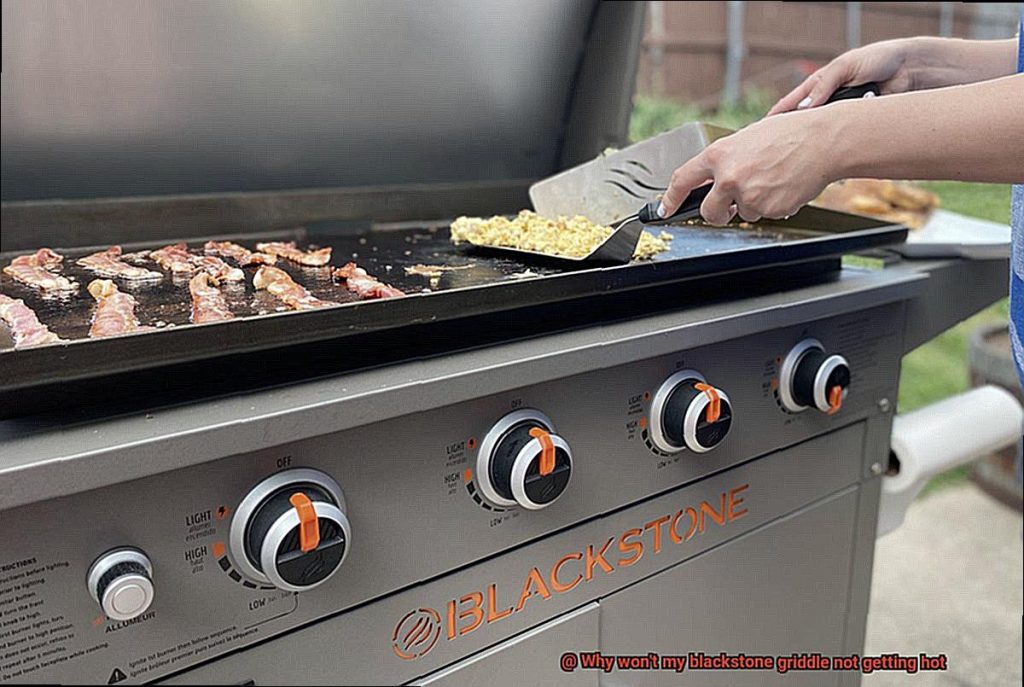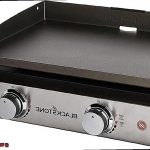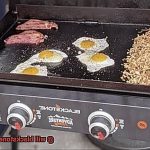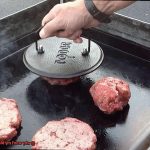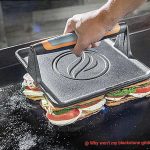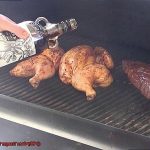Hey there, grill enthusiasts. Picture this: you’re all set to cook up a storm on your Blackstone griddle, but something’s not right. The burners are turned up high, yet your favorite dishes are taking forever to cook. Frustrating, right? Well, don’t worry. You’re not alone in facing this common issue.
But why won’t your Blackstone griddle get hot enough? It could be something as simple as a low propane tank or a faulty regulator. Or perhaps there’s a more serious problem like a clogged burner or damaged ignition system at play. Not only do these issues affect the grill’s performance, but they can also pose safety hazards.
Don’t let a malfunctioning Blackstone griddle ruin your next BBQ bash. We’ve got you covered with some practical suggestions for troubleshooting the problem. Whether you’re a seasoned grill master or new to the BBQ scene, we’ll equip you with the knowledge you need to get that grill fired up again.
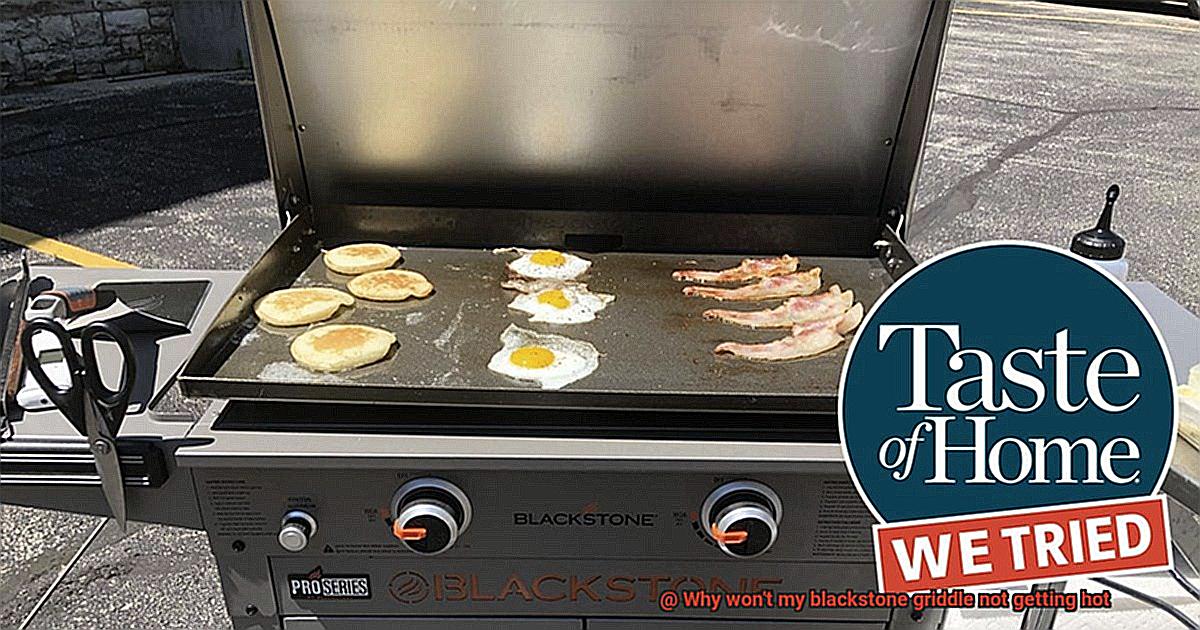
In this blog post, we’ll explore potential causes of the issue and offer solutions for getting your Blackstone griddle back in action. So grab your spatula and let’s dive into the world of grill troubleshooting.
Contents
Reasons Why Your Blackstone Griddle Is Not Getting Hot
There’s nothing worse than preparing for a delicious outdoor barbecue only to find out that your Blackstone griddle isn’t heating up. If you’re experiencing this issue, don’t worry. There are a few reasons why your griddle may not be reaching its desired temperature, and we’re here to help you troubleshoot the problem.
Faulty or Damaged Regulator
The regulator plays a crucial role in controlling the gas flow and pressure to your Blackstone griddle. If it’s damaged or broken, it can prevent the griddle from reaching the desired temperature. To check if this is the issue, try turning off the propane tank, disconnecting the regulator from the tank, and then reconnecting it. If this doesn’t solve the problem, you may need to replace the regulator altogether.
Clogged Burners or Gas Ports
Over time, grease and debris can accumulate in the burners or gas ports of your Blackstone griddle, causing blockages and hindering heat flow. Regular cleaning of these components can prevent such blockages and ensure optimal heating. To clean out the burner tube, remove it from the griddle and use a wire brush or compressed air to clear out any blockages.
Low Gas Pressure
Low gas pressure is yet another cause of a Blackstone griddle not getting hot enough. If the gas pressure is too low, it will affect the amount of heat generated by the burners. This can be due to a lack of gas supply or a problem with the gas line leading to your Blackstone griddle.
Faulty Ignition System
Without a working ignition system, you won’t be able to light up the burners and generate heat on your Blackstone griddle. Try manually lighting the burner with a long lighter or match. If this works, then you may need to replace the ignition system.
Environmental Factors
Finally, don’t forget to consider environmental factors such as wind or cold temperatures. Wind can affect the heat flow of your griddle, so try moving it to a more sheltered area or using a wind guard to protect it from gusts of wind.
In conclusion, a Blackstone griddle that fails to heat up can be frustrating, but there are several reasons why this may be happening. Understanding these reasons and troubleshooting the issue can help you ensure optimal performance and prevent such issues from occurring in the future.
Propane Tank Issues
Fear not, as this common problem can often be attributed to the propane tank. Propane is the fuel that powers most gas grills, including Blackstone griddles. If the propane tank is empty, low, or faulty, it can prevent the griddle from heating up correctly.
Let’s start by checking if the propane tank is the culprit. Turn off the control knobs and disconnect the regulator hose from the tank. Slowly open the valve on the propane tank and listen for any hissing or leaking sounds. If you detect a leak or smell gas, turn off the valve immediately and do not use the tank. Instead, replace it or have it inspected by a qualified professional.
Assuming there are no leaks, reconnect the regulator hose to the tank and turn on the control knobs to ignite the griddle. If there is still no heat or weak heat, try adjusting the pressure regulator by turning its knob clockwise or counterclockwise to increase or decrease the flow of gas. Consult your owner’s manual for specific instructions on how to adjust the pressure regulator for your model.
If adjusting the pressure regulator does not solve the problem, try replacing the propane tank with a new or full one. Make sure to use a compatible and certified propane tank that matches your griddle’s size and rating. Check for any expiry dates or damage on the tank before purchasing or using it.
In addition to these potential issues, here are some other factors to consider when it comes to propane tanks:
- Empty Tank: Running out of gas mid-grilling session? Check your gauge or weigh your tank to confirm if it’s empty.
- Low Tank: Even if your propane tank isn’t empty, it may not have enough gas to power your griddle at full capacity.
- Faulty Tank: Propane tanks can develop faults over time, including leaks or damaged valves. In such cases, disconnect the tank from your griddle immediately and have it inspected by a professional.
- Incompatible Tank: Not all propane tanks are created equal. Ensure that you’re using a compatible and certified tank that matches your griddle’s size and rating.
- Expired Tank: Propane tanks have expiry dates stamped on them. If your tank is expired, replace it with a new one.
Clogged Burners
Don’t let clogged burners ruin your grilling experience. Over time, grease, food debris, and other particles can accumulate in the burners, leading to an inadequate flame. But don’t worry – this is a common problem that can be easily remedied.
First, for safety reasons, turn off your griddle and disconnect it from the propane tank. Then, remove the griddle top and inspect the burners for any visible blockages. If you notice any debris, use a soft-bristled brush or compressed air to clean out the burners. This simple cleaning technique may be all you need to get your griddle heating up properly again.
However, if your burners appear to be clean and your griddle still won’t heat up properly, the problem may lie with a faulty regulator. Regulators control the flow of propane to your grill’s burners. If they become damaged or worn out, they can disrupt proper heating.
To check your regulator for damage or wear and tear, turn off your griddle and disconnect it from the propane tank. Inspect the regulator for any visible signs of issues. If you notice any problems, it’s recommended that you replace the regulator to ensure optimal performance.
Ignition System Problems
One possible culprit for this issue is ignition system problems. As an expert on this topic, let’s explore the potential causes of ignition system issues and how to resolve them.
Firstly, a faulty igniter is a common problem with the ignition system. The igniter creates the spark that ignites the propane gas, heating up the griddle surface. If the igniter is not functioning correctly, there won’t be a spark to ignite the gas, resulting in an unheated griddle surface. Replacing the igniter may be necessary to solve this issue.
Secondly, a clogged or damaged burner tube can also cause ignition system problems. The burner tube delivers propane gas to the griddle surface, and if it’s not functioning correctly, gas may not flow properly. This can result in uneven heating across the griddle surface or a lack of heat output. To solve this issue, clean out any debris from the burner tube or replace it entirely.
Lastly, a low propane gas supply could be behind ignition system problems. If your propane tank is low or empty, there won’t be enough fuel to ignite and heat up the griddle surface. Make sure to regularly check your propane tank level and refill it as needed.
To ensure that your Blackstone griddle functions correctly and heats up as expected, it’s essential to inspect and maintain its ignition system regularly. If you’re having trouble getting your griddle hot, check for ignition system problems as one possible cause. Follow these tips to get back to cooking up delicious meals in no time:
- Check for a faulty igniter and replace it if necessary
- Clean out debris from the burner tube or replace it entirely
- Regularly check your propane tank level and refill as needed
Environmental Factors
The answer may lie in environmental factors. Wind, humidity, temperature, and sunlight exposure all play a crucial role in how your griddle operates and how your food tastes.
Let’s start with wind. If you’re cooking on a windy day or in an area with strong gusts, it can impact your griddle’s ability to maintain a consistent temperature. This can lead to uneven cooking or slower cooking times. Protect your griddle from the wind by placing a wind block around it or moving it to a more sheltered spot.
Humidity is another factor to consider. High levels of moisture in the air make it harder for your griddle to heat up quickly. To speed up the preheating process, cover your griddle or move it to an area with lower humidity levels.
Temperature also affects your griddle’s performance. Extremely cold temperatures can cause heat loss more quickly, resulting in longer preheating times and potentially lower cooking temperatures. Combat this issue by preheating your griddle for a bit longer than usual or using a cover to trap the heat.
Lastly, don’t underestimate the power of sunlight exposure. Too much sun exposure can make your griddle too hot and difficult to control, while placing your griddle in a shaded area may result in longer preheating times and not reaching optimal cooking temperatures. Find a spot for your griddle that offers a good balance of sun and shade.
Troubleshooting Steps to Get Your Griddle Hot Again
Don’t fret. There are various troubleshooting steps you can take to get your griddle revving again.
The first thing you should check is the propane tank and gas line for blockages or leaks. If the tank is empty, switch it out with a new one. If the gas line is damaged or blocked, replace it too.
Next, examine the regulator and make sure it’s securely attached to both the propane tank and griddle. The regulator controls the flow of gas, so if it’s not functioning correctly, it can cripple your griddle’s heat output.
Thirdly, take a gander at the burner tubes and make sure they’re spotless and free of any debris or buildup. These tubes distribute heat evenly across the cooking surface, so if they’re clogged, they can hinder your griddle from getting hot.
Moreover, don’t overlook the igniter system; ensure that it’s lighting the gas and starting the heating process as intended. If something seems amiss with this system, your griddle may not get hot.
If all else fails, don’t hesitate to reach out to Blackstone’s customer service for further assistance. Their team of experts can troubleshoot any issues with your griddle and provide solutions to get it hot again.
Tips for Avoiding This Problem in the Future
Here, I will expand upon the tips for avoiding issues with heating up your Blackstone griddle in the future.
Proper Heating
One of the most important steps you can take to avoid problems with your griddle is to ensure it’s properly heated up before cooking. This not only ensures that your food cooks evenly but also helps prevent any damage to the griddle itself. Always give your griddle enough time to heat up before cooking, and use a high-quality thermometer to ensure that it has reached the desired temperature.
Regular Maintenance
Another crucial step in maintaining a functioning griddle is regular maintenance. After every use, clean off any grease or debris that has accumulated on the surface and check for any signs of wear or damage. This ensures that your burners and other components are working at peak efficiency and prevents issues with heating up properly.
Propane Tank Quality
Using low-quality or dirty propane tanks can cause issues with the flow of gas, resulting in a lack of heat on the griddle. To avoid this problem, always use high-quality propane tanks and check them for leaks or other issues before use. Additionally, make sure that the propane tank is properly connected to the griddle to avoid any issues with gas flow.
Adjust Heat as Needed
It’s important to adjust the heat as needed when cooking on your Blackstone griddle. Cooking on low heat for too long can cause the griddle to cool down, while cooking on high heat for extended periods can damage the griddle. Make sure to adjust the heat accordingly to ensure that your food cooks properly and your griddle stays in good condition.
Proper Storage
Finally, proper storage is essential for keeping your Blackstone griddle in good working order. Store it in a dry and cool location, away from direct sunlight and moisture. This helps prevent rust and other damage that can affect its ability to heat up properly.
Benefits of Using a Blackstone Griddle
Look no further than a Blackstone griddle, the versatile and efficient cooking option that will make you the star of your next barbecue or camping trip. As an expert in the field, I can attest to the numerous benefits of using a Blackstone griddle. Here are just a few:
Versatility is key when it comes to cooking, and a Blackstone griddle offers just that. With this powerhouse appliance, you can cook a wide range of dishes, from fluffy pancakes and perfect sunny-side-up eggs to juicy burgers and sizzling steaks. The even heat distribution ensures that your food is cooked evenly and thoroughly, making it perfect for any type of cooking.
The large cooking surface of a Blackstone griddle takes things up another notch by allowing you to cook for a large group of people at once. You can prepare multiple dishes simultaneously, which is not possible with traditional grills or stovetops. And let’s not forget about the easy cleanup. Thanks to its flat surface, cleaning a Blackstone griddle is a breeze. The grease management system also collects excess oil and grease in a removable tray, making disposal effortless.
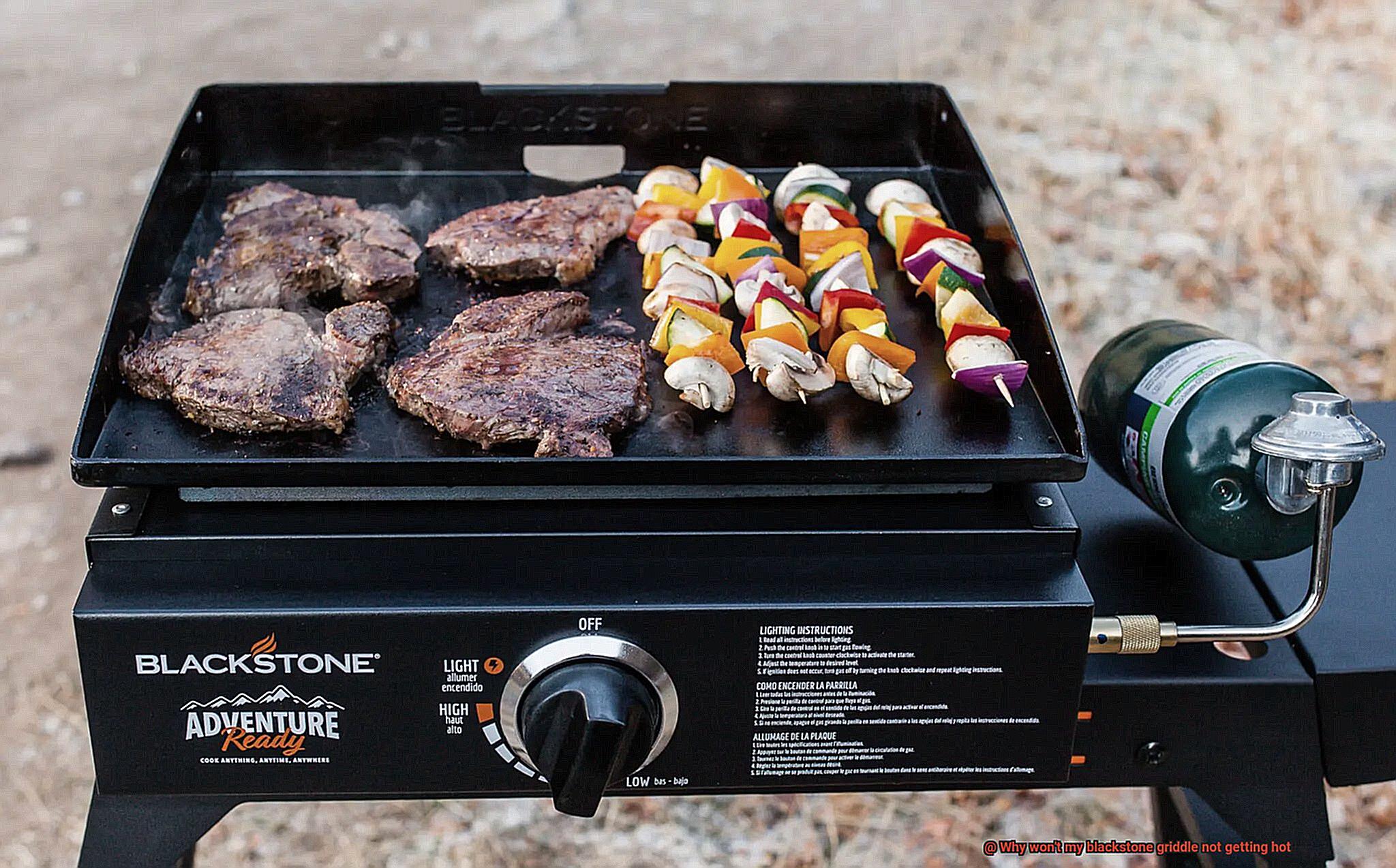
Using a Blackstone griddle can also save you precious time. It heats up quickly and cooks food faster than traditional grills or stovetops, which means you can spend less time hovering over the stove and more time enjoying your delicious creations with your loved ones.
But that’s not all. Blackstone griddles are designed specifically for outdoor use, making them the perfect addition to any barbecue, camping trip, or outdoor adventure. They are portable and easy to transport, which means you can take them with you wherever you go. Imagine impressing your friends and family with your culinary skills while lounging by the lake or in your own backyard.
How to Properly Maintain Your Blackstone Griddle
Maintaining your Blackstone griddle is crucial if you want to achieve optimal performance and longevity from your investment. A well-maintained griddle ensures that you can cook up delicious meals efficiently without any heating issues or uneven cooking. Here are five sub-sections to explain how to properly maintain your Blackstone griddle.
Clean Your Griddle After Every Use:
Cleaning your griddle after every use is vital to ensure it stays in top condition. You can use a scraper or spatula to remove any excess food and then apply a griddle cleaner to the surface for a thorough clean. Scrub with a brush or scouring pad, rinse off with water, and dry it thoroughly before using it again. A dirty griddle can cause uneven heating and temperature fluctuations that make it challenging to cook food properly.
Season Your Griddle:
Seasoning your griddle is an essential maintenance step that improves its non-stick properties and protects its surface from rust. To season your griddle, apply a layer of oil to the surface and heat it until it starts smoking, then let it cool down and wipe off any excess oil.
Check Your Gas Supply:
If your Blackstone griddle isn’t heating up correctly, check the gas supply and connection between the tank and the griddle. Make sure the gas tank has enough fuel and that the connection is secure and leak-free.
Inspect Your Burners:
Regular inspection of your burners and ignition system can help identify any faulty parts that may be causing heating issues. If you notice any wear or damage to the burners or ignition system, seek a professional’s assistance for repair or replacement.
Troubleshoot Low Heat Output:
Low heat output can be due to several reasons, including a clogged burner tube, an empty propane tank, or a stuck regulator. Clean the burner tube thoroughly if there’s grease buildup, ensure that the propane tank is full and correctly connected, and try turning off the gas supply, disconnecting the regulator, and then reattaching it firmly.
Common Mistakes When Using a Blackstone Griddle
There are some common mistakes that can prevent your griddle from heating up correctly. Here’s what you need to know:
Firstly, preheating your Blackstone griddle is essential for even cooking. Without preheating, you risk undercooking or overcooking your meals. So, remember to turn on your griddle and let it heat up for at least 10 minutes before cooking.
Using the wrong type of oil can also affect the heating of your griddle. Stick to high smoke point oils like vegetable or canola oil to prevent burning and smoke, which can impact the temperature of your griddle.
While using enough oil to prevent food from sticking is crucial, using too much oil can cause it to pool on the surface and prevent even heating. So, use just enough oil for your cooking needs.
Overcrowding the griddle is another common mistake that leads to uneven heating. Ensure you leave enough space between each item you’re cooking so that heat can circulate evenly around each piece. This will prevent any cold spots on the griddle and ensure everything cooks through properly.
Lastly, if your Blackstone griddle is still not getting hot, check all burners are working correctly and there are no blockages in the gas lines. A faulty burner or blocked gas line can prevent your griddle from heating up properly. Always check these things before starting to cook.
0yTx26tECOg” >
Conclusion
If you’re struggling with a Blackstone griddle that’s not heating up properly, don’t worry – there are a few things you can try to troubleshoot the issue.
And if all else fails, don’t hesitate to reach out to Blackstone customer service for additional support.

